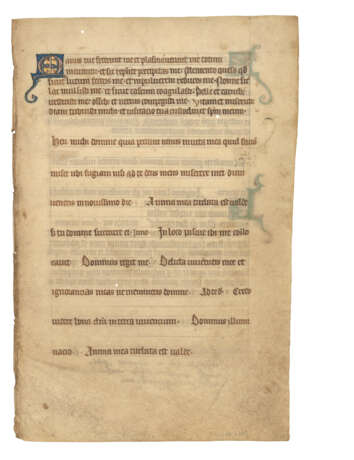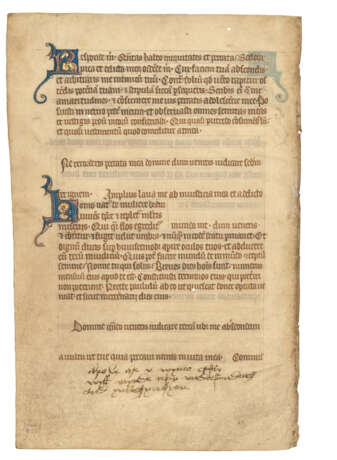ID 869499
Lot 92 | A new liturgical Use
Estimate value
£ 1 000 – 1 500
Leaf from an unfinished Office of the Dead, Unidentified (Peterborough or Ely?) Use, from the Iken Psalter, in Latin, illuminated manuscript on vellum [England, East Anglia, late 13th or early 14th century].
A fine leaf from a deluxe illuminated East Anglian Psalter, its text apparently revealing for the first time a particular liturgical Use; annotated in Middle English.
c.265 × 179mm. Ruled in plummet for up to 30 lines of text, or fewer lines of text with music for which lines have been left blank, without staves or notation, two-line illuminated foliate initials introduce each reading, blank spaces also for rubrics, for which notes to the rubricator are visible (‘a’, ‘p’, ‘r’, and ‘v’, for antiphons, psalms, responsories, and versicles); the text comprising the end of the first and beginning of the second nocturns, with the third to fifth lessons, with their responsories and versicles (‘Manus tue fecerunt […] Commis[sa mea]’) (slight darkening at the edges, and faint offsets from facing illuminations, but overall very fine).
Provenance:
(1) Perhaps written for the church of St Botulph at Iken in Suffolk: Botulph was one of only three English saints in the litany of the parent manuscript, together with Dunstan and Edmund; a full-page drawing of King Edmund (whose relics were at Bury St Edmunds) was added on a flyleaf in the 15th century (now Beinecke Library, Takamiya MS 136); a flyleaf note referred to Orford, which is only about 4 miles or 6km south of Iken.
(2) The present leaf with a 15th/16th-century inscription in English on the five wits: ‘thes be the v wyttes gostly wyll mynde reson undrestondeng and ymagynasyon’.
(3) The parent volume, still in a 15th-century binding, was sold at Sotheby’s, 10 December 1969, lot 36, with full-page plate, to Charles Traylen, and offered by him in his Catalogue 77 (1972); broken-up by Bruce Ferrini by 1980, leaves are now at the Cleveland Museum of Art and at Stanford, Cornell, and Ohio State Universities.
(4) Bernard Quaritch, Catalogue 1036: Bookhands of the Middle Ages [I]: Medieval Manuscript Leaves, Principally from a Collection Formed in the 19th Century (London, 1984), no. 17 (with full-page plate).
(5) Colker MS 421; acquired in 1990 from Quaritch.
Text
Very surprisingly, the text of the present leaf does not correspond to the widespread Use of Sarum, but instead corresponds closely to the otherwise unrecorded Office of the Dead in a 15th-century Psalter made for use in or near Ely, to judge by its litany (Cambridge, Trinity College, MS. B.11.6), and to the 14th-century Barlow Psalter, thought to have been made for Ramsey Abbey and adapted for Peterborough Abbey (Bodleian Library, MS. Barlow 22), and, according to Knud Ottosen, a Peterborough Antiphonary (Cambridge, Magdalene College, MS F.4.10).
It is interesting that the illumination was completed – to a high standard – but the music was not: usually the music would be provided before the illumination.
| Genre: | Religious genre |
|---|---|
| Place of origin: | United Kingdom |
| Auction house category: | Medieval & renaissance manuscripts |
| Genre: | Religious genre |
|---|---|
| Place of origin: | United Kingdom |
| Auction house category: | Medieval & renaissance manuscripts |
| Address of auction |
CHRISTIE'S 8 King Street, St. James's SW1Y 6QT London United Kingdom | |
|---|---|---|
| Preview |
| |
| Phone | +44 (0)20 7839 9060 | |
| Buyer Premium | see on Website | |
| Conditions of purchase | Conditions of purchase |




